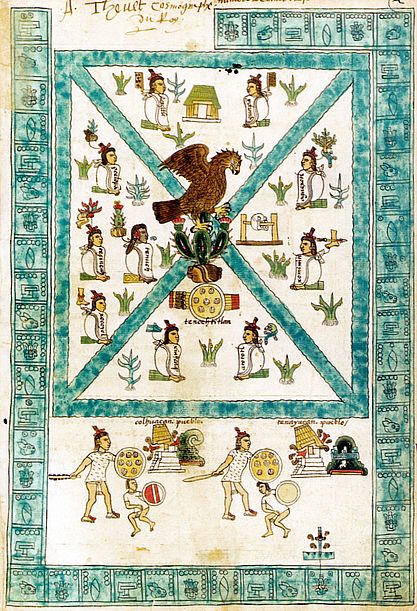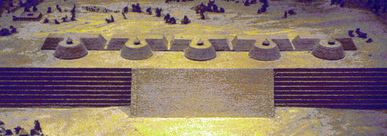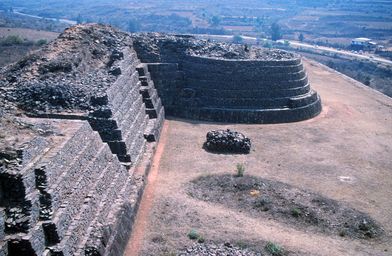
This "map" from the Codex Mendoza represents Tenochtitlan at the center of the world, with place glyphs for the surrounding communities from which tribute was expected.
Content created: 2008-08-21
Part 12
Part 14
The great suffering produced by the seven-year famine in the Valley of Mexico itself made it sensible to conquer more territory outside of the valley in other eco-systems, and between the wonderful harvest of 1455 and Emperor 5's death a decade and more later, Aztec military efforts extended to much more distant areas than they had undertaken earlier, places where people did not speak Náhuatl. Aztec armies reached the coast of the Gulf of Mexico by 1458 and conquered the peoples who were to become Cortés' allies in the final conquest of Tenochtítlan two generations later: the Huastecs of northern Veracruz, and the Totonacs to the south of them. To the south of Tenochtítlan, Aztec armies drove into the territory of the Mixtecs (also called Ñuu Savi) in the modern state of Oaxaca. Chálco, after a 90 year struggle, finally fell for the fourth and last time in 1465.
A few Nahua towns still stubbornly resisted Aztec domination. Aztec armies besieged and conquered the Nahua town of Tepeyácac ("mountain ridge," modern Tepeaca) south of Tlaxcállan, cutting into Tlaxcállan's own mini-empire, but they did not succeed in subduing Tlaxcállan itself, which remained forever the Aztecs' most important foe among the Nahua.
As we noted, the Aztec empire was never a single, continuous stretch of land. It always consisted of conquered settlements expected to deliver tribute (or else!), and they in turn sought to collect some of that tribute from conquered towns of their own (or else!). Tribute demands were high. If they thought they might have any prospect at all of success, most of the towns that made up the empire were well motivated to rebel, especially when the central government was weakened temporarily by the death of an emperor.

The Codex Mendoza, the source of the tribute list mentioned earlier, also contains a list of the towns conquered by each emperor. Each conquered town was represented with a picture of a burning temple accompanied by a place glyph. Beside these the Spanish compiler has provided clarifying annotations. The list contains the names of 192 conquered communities, and inspection of the list shows that several had to be conquered more than once. Chalco was subdued four different times (by Emperors 2, 3, 4, and 5), and Cuauh-náhuac three times (by Emperors 1, 4, and 5). An additional fourteen communities were conquered twice each. However, if the codex listing is to be believed, 176 communities seem to have learned their lesson the first time.
A few such rebellions confronted every Aztec emperor, including Moteuczóma I's successor and grandson, Axcayatl ("wet face," Emperor 6). Emperor 6 had been on the throne only four years when his discontent with the insubordination of the market town of Tlatelólco to the north of Tenochtítlan boiled over. Tlatelólco, we remember, was the large settlement and famous market on the north end of the same island (Acatzíntlan) on which Tenochtítlan was located. It had been semi-independent ever since the first Aztec royalty had been created as borrowed princes were married to women from the Mexica calpólli. Early in the reign of Axcayatl as Emperor 6, or possibly slightly before, a man named Moquíhuix, the ruler of Tlatelólco, had married Axcayatl's sister, and either unkindness to her or outright abuse of her gave the sixth emperor the pretext that [Tlacahélel felt] was needed for an outright annexation of Tlatelólco, and its "royal house" was ousted. Tlatelólco was ruled ever after by a military governor appointed in Tenochtítlan.


Politically, it was probably a good move. The two towns had long since grown into each other, and their complete merger was probably efficient. But it also underlined very clearly that nobody could risk the emperor's displeasure. We readily imagine other towns asking themselves, "if even Tlatelólco cannot assert itself against its brethren in Tenochtítlan, what chance has anyone else?"
By 1478, thirty years after the first Aztec conquests on the coast of the Gulf of Mexico, the forces of Tenochtítlan subdued Tuxpan, the last of the holdout Huastec towns, leaving the Aztecs free to turn their attention to the project of marching to the Pacific Coast. In their way lay the state of the Tarascans and their great city of Tzintzuntzan, and so a campaign against the Tarascans was immediately undertaken.
To their own astonishment, the Aztecs were completely and definitively defeated. (Many people one meets in Tzintzuntzan today are still inclined to be pleased at this.) Although Aztec forces did eventually reach the Pacific Coast, they did so in regions well south of Tarascan territory. Their defeat at the hands of the Tarascans was humiliating, but it was not humbling; instead, it was understood as a caution against military complacency, a reason to keep the army in top condition.
| « Part 12 |
Contents Glossary, Bibliography | Part 14 » |